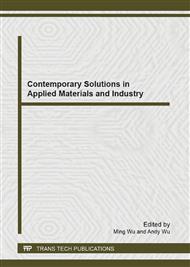[1]
Aksoy, A., Leblebici, Z., Bağci, Y., (2011). Determination of heavy metal pollution in some honey samples from Yozgat province, Turkey. Environ. Earth Sci., 1037-1043.
DOI: 10.1007/978-3-540-95991-5_98
Google Scholar
[2]
Bilandžić, N., Đokić, M., Sedak, M., Kolanović, B.S., Varenina, I., Končurat, A., Rudan, N., (2011). Determination of trace elements in Croatian floral honey originating from different regions. Food Chem. 128, 1160-1164.
DOI: 10.1016/j.foodchem.2011.04.023
Google Scholar
[3]
Buldini, P.L., Cavalli, S., Mevoli, A., Sharma, J.L., (2001). Ion chromatographic and voltammetric determination of heavy and transition metals in honey. Food Chem. 73, 487-495.
DOI: 10.1016/s0308-8146(01)00132-7
Google Scholar
[4]
Cao, H., Qiao, L., Zhang, H., Chen, J., (2010). Exposure and risk assessment for aluminium and heavy metals in Puerh tea. Sci. Total Environ. 408, 2777-2784.
DOI: 10.1016/j.scitotenv.2010.03.019
Google Scholar
[5]
Citak, D., Silici, S., Tuzen, M., Soylak, M., (2012). Determination of toxic and essential elements in sunflower honey from Thrace Region, Turkey. Int. J. Food Sci. Tech. 47, 107-113.
DOI: 10.1111/j.1365-2621.2011.02814.x
Google Scholar
[6]
Devillers, J., Doré, J.C., Marenco, M., Poirier-Duchêne, F., Galand, N., Viel, C., 2002. Chemometrical analysis of 18 metallic and nonmetallic elements found in honeys sold in France. J. Agric. Food Chem. 50, 5998-6007.
DOI: 10.1021/jf020497r
Google Scholar
[7]
Conti, M.E., (2000). Lazio region (central Italy) honeys: a survey of mineral content and typical quality parameters. Food Control 11, 459-463.
DOI: 10.1016/s0956-7135(00)00011-6
Google Scholar
[8]
Przybyłowski, P., Wilczyńska, A., (2001). Honey as an environmental marker. Food Chem. 74, 289-291.
DOI: 10.1016/s0308-8146(01)00153-4
Google Scholar
[9]
Golob, T., Doberšek, U., Kump, P., Nečemer, M., (2005). Determination of trace and minor elements in Slovenian honey by total reflection X-ray fluorescence spectroscopy. Food Chem. 91, 593-600.
DOI: 10.1016/j.foodchem.2004.04.043
Google Scholar
[10]
Hang, X., Wang, H., Zhou, J., Ma, C., Du, C., Chen, X., (2009). Risk assessment of potentially toxic element pollution in soils and rice (Oryza sativa) in a typical area of the Yangtze River Delta. Environ. Pollut. 157, 2542-2549.
DOI: 10.1016/j.envpol.2009.03.002
Google Scholar
[11]
Inoue, K., Murayama, S., Takeba, K., Yoshimura, Y., Nakazawa, H., (2003). Contamination of xenoestrogens bisphenol A and F in honey: safety assessment and analytical method of these compounds in honey. J. Food Compos. Anal. 16, 497-506.
DOI: 10.1016/s0889-1575(03)00018-8
Google Scholar
[12]
IOM (Institute of Medicine), (2002).
Google Scholar
[13]
US EPA, (1997). Guiding Principles for Monte Carlo Analysis, Environmental Protection Agency, Risk Assessment Forum, Washington DC.
Google Scholar
[14]
US EPA, (1999). Guidance for Performing Aggregate Exposure and Risk Assessments, Environmental Protection Agency, Office of Pesticide Programs, Washington DC.
Google Scholar
[15]
Wilbur, S.B., Hansen, H., Pohl, H., Colman, J., McClure, P., (2004). Using the ATSDR Guidance Manual for the Assessment of Joint Toxic Action of Chemical Mixtures. Environ. Toxicol. Pharmacol. 18, 223-230.
DOI: 10.1016/j.etap.2003.03.001
Google Scholar
[16]
Paustenbach, D.J., (2000). The practice of exposure assessment: a state-of-the-art review. J. Toxicol. Env. Heal. B 3, 179-291.
Google Scholar
[17]
SAC/MOHC (Standardization Administration China/Ministry of Health, China), 2011. Chinese Hygienic Standard for Honey. GB14963-2011, SAC/MOHC, Beijing.
Google Scholar
[18]
SAC/MOHC (Standardization Administration China/Ministry of Health, China), 2005. Maximum Levels of Contaminants in Foods. GB2762-2005, SAC/MOHC, Beijing.
Google Scholar


